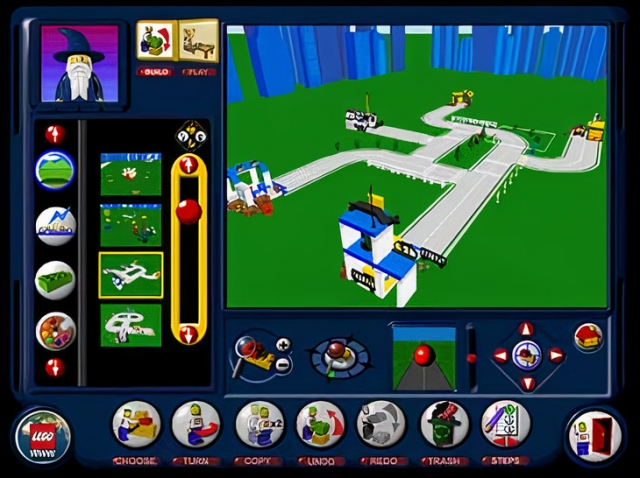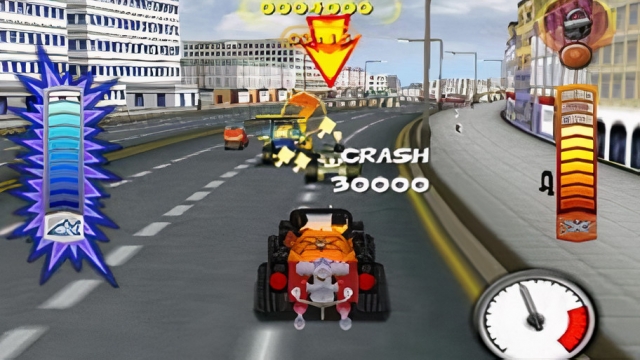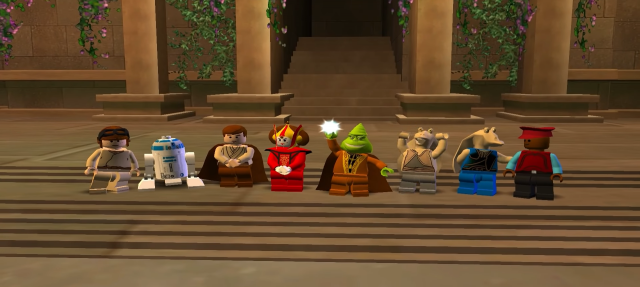
A History of LEGO Games
If asked what a LEGO game is, most would respond with something along the lines of “a collect-a-thon developed by Traveller’s Tales, now known as TT Games, that loosely retells existing stories in a cutesy, brick world.” Those people would, primarily, be correct, at least by modern standards. For the past 15 years, TT has released amazing hits centering around these LEGO game adaptations of classic titles, such as Star Wars and both DC and Marvel comics. Today, LEGO games are a nigh-unstoppable force and a staple of adventure games. However, it wasn’t always this way.

LEGO Fun to Build's Aquazone Level - Source: Brickpedia
The first LEGO-branded videogame wasn’t even an adventure game. Instead, The LEGO Group and SEGA developed a puzzle title for the SEGA Pico in 1995 to Japanese audiences, titled LEGO Fun to Build. Arguably, a puzzle game on the primarily education-focused console was a perfect choice for a brand of childrens’ interlocking brick toys, but Fun to Build never made its way outside of Japan. Not even Denmark, the home of The LEGO Group, received any official distribution, due to the general failure of the Pico’s sales in European markets.
In LEGO Fun to Build, the player could explore four levels based around existing LEGO sets, with each level featuring five-to-six building puzzles. These puzzles tasked the player with quickly putting together digital versions of real-life LEGO structures, differing depending on whether the level’s theme was Town, Aquazone, Castle, or Space. Once the LEGO bricks were put together, Fun to Build offered minigames, again depending on the level. Some were essentially claw machines and others were straight-up races. Still, there was a lot of variety, and the game even offered a bonus level called Free Build Mode, where the player could edit any of the objects or structures they interacted with the game proper, or even put together their own from scratch.
Following this, most LEGO games would find their homes on PCs and would furthermore be released worldwide. First of these was LEGO Island in 1997, from Mindscape, a French company then owned by Pearson and struggling to regain its profitability. LEGO Island, an action-adventure game that allowed its players to explore an island made up of LEGO sets and play up to five characters, wound up serving as just the title to rejuvenate the company. While there were many avenues to explore in Island, the game primarily centered around building structures and vehicles (with the help of a man named Bill Ding, no less) and delivering pizza to various locations. There was even a brief storyline where protagonist Pepper Roni must catch the notorious escaped criminal, The Brickster, before he can destroy every building on the island.
LEGO Island’s success also prompted The LEGO Group to invest heavily in the videogame market, forming the publishing subdivision LEGO Media. In 1998, the year following LEGO Island, LEGO Media released three titles, each from a different developer and all for PCs. First, from Intelligent Games, was LEGO LOCO, a sandbox construction game which tasked players with building a town or city, complete with a train and train tracks, and raising their population. Second, Krysalis Software crafted LEGO Chess. LEGO Chess, in addition to its pirate and western-themed chess sets, introduced multiplayer to the franchise, allowing friends to play chess against each other, but with LEGO bricks. Last, but certainly not least, from the Superscape came LEGO Creator, the first in a series of simulation games that gave the player free range to build with LEGO bricks in specific themes, starting here with Town sets.

LEGO Creator's User Interface - Source: Wikipedia
LEGO Creator would go on to see three sequels: LEGO Creator: Knights’ Kingdom in 2000, which featured a fight against a character by the name of Cedric the Bull; LEGO Creator: Harry Potter in 2001, the first licensed LEGO game and released in the same year as the film it was based on, Harry Potter and the Philosopher’s Stone; and Creator: Harry Potter and the Chamber of Secrets, which is notable for being the only title in the Creator series that was not developed by Superscape, with the job instead going to Qube Software.
Jumping back to 1999, LEGO Media had three more videogames published for PCs, and they were expanding beyond the basic idea that LEGO games should be primarily focused on building structures. From Ivanoff Interactive, there was LEGO Friends, which followed a group of friends (that was also a band named “Tuff Stuff”) from the Scala line of LEGO’s non-LEGO toys. Featuring absolutely no actual LEGO bricks, the game followed the day-to-day antics of the group and featured several options for putting together musical numbers, including dances, backgrounds, and songs, both vocal and instrumental.

LEGO Friends' music creator - Source: My Abandonware
From High Voltage Software came LEGO Racers, a racing game that allowed players to build their own cars. The title featured many then-recognizable Minifigures and modified LEGO sets to serve as racers and racecourses. Additionally, LEGO Racers found its way to consoles later that year, releasing on the Nintendo 64 in October and on the PlayStation in December. A year later, Climax Studios would port Racers to the Game Boy Color in December of the year 2000. Lastly, from Data Design Interactive came LEGO Rock Raiders, a Real Time Strategy game that featured the space-mining themed Rock Raiders LEGO line. In each of the game’s 25 missions, the player was expected to gather Energy Crystals, with more being required with each subsequent level. Similar to LEGO Racers, Rock Raiders would have a port to consoles in the following, but unlike Racers, the port would be very different. On the PlayStation, LEGO Rock Raiders was an action game, featuring a variety of missions that were, strangely enough, different between PAL and NTSC versions of the title.
In the year 2000, before renaming itself to LEGO Software, LEGO Media released a few more games for the PC. First was LEGOLAND, from Krisalis Software which tasked the player with (re)building a LEGO theme park in both a structured Story Mode and a Free Play Mode. From visual effects company Digital Domain came LEGO Alpha Team, a spy-themed puzzle game that was later ported to the Game Boy Color by Climax Studios. From Intelligent Studios came LEGO Stunt Rally, a racing game that allowed customisation of the racetracks. It too was ported to the GBC, though by Graphic State. Beyond these three, there were also a series of educational games for PCs and Macs by the names of LEGO My Style: Preschool and Kindergarten from Stormfront Studios.

LEGO Island 2: The Brickster's Revenge - Source: My Abandonware
With a new name in hand, LEGO Software rang in the new year of 2001 with the release of LEGO Island 2: The Brickster’s Revenge, from Silicon Dreams Studio. This sequel, released on PCs and the PlayStation, expanded the scope of the prior game by requiring that returning protagonist Pepper Roni visit several islands to rebuild his own and stop the Brickster in his tracks. Smaller versions were also released for the Game Boy Color and later the Game Boy Advance from Crawfish Interactive. Another sequel, LEGO Racers 2, came from Hatton, England-based Attention to Detail, and was released for the PC and the PlayStation 2, with a Game Boy Advance release developed by the British Pocket Studios. Additionally, for the first time since 1995, a LEGO game was made without the PC in mind, with LEGO BIONICLE: Quest for the Toa, developed by Saffire for the GBA. This isometric action-platformer marked the first videogame of the popular BIONICLE line of LEGO products.
With another name change to LEGO Interactive in 2002, the publisher began co-producing their titles with Electronic Arts, releasing a whopping six games in 2002, including the aforementioned final Creator game. Most of these were further sequels of their successful products, such as Silicon Dreams’ Island Xtreme Stunts for the PC and the PS2, which followed up the LEGO Island series with Pepper Roni now starring in an action movie, Attention to Detail’s Drome Racers for the PC, GameCube, and the PS2, a sleeker sequel to LEGO Racer 2, and British developer Argonaut Games’ BIONICLE: Matoran Adventures for the GBA.

Island Xtreme Stunts - Source: PlayStation
Beyond the sequels, there was also the poorly received Football Mania from Silicon Dreams for the PC and PS2, in which you could play football, but with LEGO bricks, and Asylum Entertainment’s Galidor: Defenders of the Outer Dimension, an action-adventure game for PCs that was based on the LEGO line of toys that were in turn based on the children’s sci-fi series of the same name. All of these games were also ported to the GBA, save for Matoran Adventures for what should be obvious reasons. Further, THQ published nearly all of these ports, after a deal with LEGO that gave them the publishing rights for their GBA lineup. Oddly enough, not a single LEGO game from 2002 featured the “LEGO” name in their title, despite more than half of the videogames being sequels to prior installments.
Then, LEGO Interactive slowed down, only publishing Argonaut Games’ BIONICLE: The Game in 2003 for PCs, the GameCube, the PS2, and the Xbox, with a GBA port from Möbius Entertainment, to poor reviews and sales. With this, LEGO Interactive was disbanded, its employees going on to form Giant Interactive Entertainment. With 2004 seeing only THQ publishing the British Razorback Developments’ LEGO Knights’ Kingdom, a top-down action-adventure title for the GBA, the future of LEGO games looked bleak. 2005 came and wasn’t looking too much better, with only another THQ-published GBA title, Razorback Developments’ BIONICLE: Maze of Shadows.

LEGO Star Wars: The Video Game - Source: Brickpedia
However, then came the franchise’s saving grace: LEGO Star Wars: The Video Game, developed by Knutsford, England-based Traveller’s Tales and published by Eidos Interactive and Giant Interactive Entertainment. Adapting the Star Wars series’ Prequel Trilogy, the game was a veritable collect-a-thon powerhouse, garnering multitudes of sales and adequate reviews, regaining The LEGO Group’s trust in LEGO videogames. Releasing for PCs, Macs, PS2s, GameCubes, Xboxes, and featuring a GBA port from Griptonite Games, audiences played through shortened versions of the three films, collecting a currency known as studs and multiple Minikit Canisters per level, which combined to form vehicles. As an added bonus, the final film in the Prequel Trilogy wouldn’t be released for a few more months, essentially allowing players a first go at experiencing the epic conclusion. Overall, it was like catching lightning in a bottle, and once the dust settled, Traveller’s Tales was given the reins over the franchise’s foot in videogames. From there, the developer purchased and merged with Giant Interactive to form TT Games. Since then, the past 15 years have shown great heights for LEGO’s games, helping to make The LEGO Group one of the largest brands on the planet.








COMMENTS